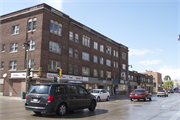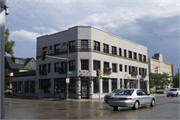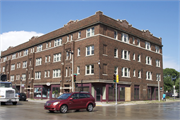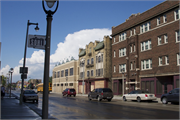27th and Wells Commercial Historic District
Milwaukee County, Milwaukee
The 27th and Wells Commercial Historic District encompasses a group of seven commercial buildings constructed over a twelve-year period in the early twentieth century. In 1910, the area around the intersection of 27th Street (still referred to interchangeably as Washington Avenue) and Wells Street was characterized by wood frame dwellings with one or two brick homes per block. Between 1920 and 1930, the neighborhood’s population increased more than 50 percent. By 1930, this increase in density had forever altered the neighborhood. At the intersection of 27th and Wells, a cluster of two- to four-story brick commercial and apartment blocks anchored by the new Tower Theater replaced the frame houses in every direction.
Milwaukee’s 27th Street streetcar line was expanded to offer crosstown service in 1913. At this time, it was the first crosstown route, linking many important city neighborhoods without traversing the central business district. It was also the longest north-south route, providing one of the only access points to the Menomonee Valley. Land along this major thoroughfare tended to rise exponentially in value, driving density. The expanding residential market propelled by the mobility of the streetcar created a demand for neighborhood stores, grocers, hair dressers and barbers, and tailors that were readily accessible. For commercial business owners, this new “main street” was ideal because it provided a significant local customer population without the higher rents of the central business district. This combination of lower rent and access to a significant patron base also attracted entertainment venues such as the Tower Theater, restaurants, soda fountains, and a bowling alley. These businesses combined to create a mini-entertainment district along 27th Street. The Tower Theater is one of the few theaters left from Milwaukee’s movie palace era when architects incorporated highly decorative, exotic motifs to transport movie-goers to the locations of the films popular at the time.
Other such streetcar-driven “Main Streets” that existed throughout the city have been obliterated by redevelopment and neglect. Changes in American life, income distribution, and community development after World War II resulted in a deactivation of streetcars and the decline of neighborhoods surrounding the central business district. By 1960, development and improvements halted completely, in effect preserving the district as it appeared during its prime.
A group of respected Period Revival specialists designed a cluster of Period Revival and Commercial Style structures in a relatively short period of time. The Milwaukee architecture firm Dick and Bauer, who also designed the Oriental Theater, applied the Mediterranean Revival style to three of the structures in the district, including the Tower Theater. Other architects include John W. Menge, Menge’s former apprentice George Zagel, Zagel’s one-time partner Pius J. Matt, and Chicago Prairie School architect Clare C. Hosmer.
The district retains a high degree of integrity, with many of the buildings appearing as they did during the period of significance with only storefront and window alterations. The result is a cohesive group of buildings that represents an active building period of Milwaukee’s history and demonstrates the way popular styles were incorporated to greater and lesser extents depending on building use, client tastes, and budget. |





